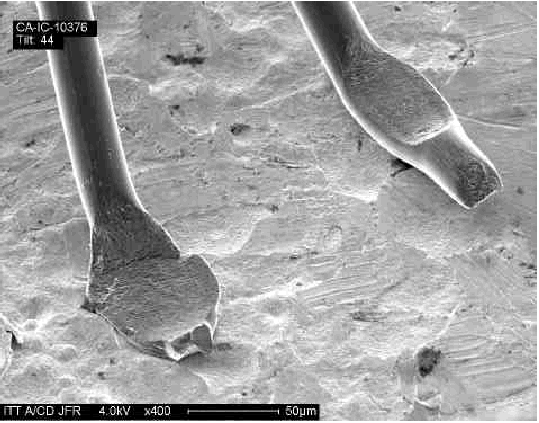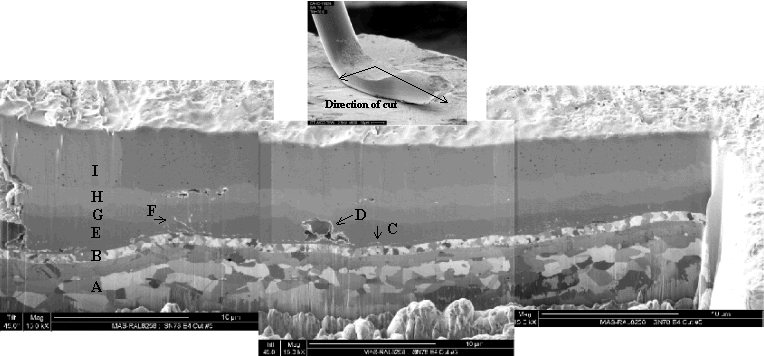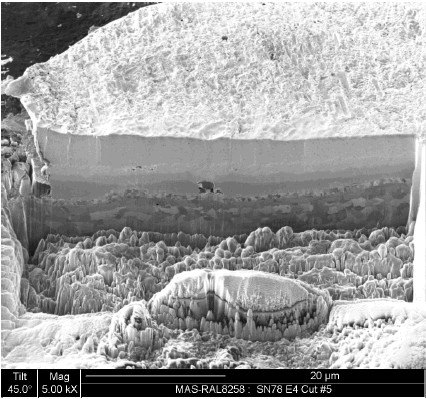GOES Sounder visible light detector
A GOES Sounder visible light detector (SN79) failed a destructive physical analysis (DPA) in early 2002, three years after its manufacture in 1999. However, a sibling device, SN78 from the same manufacturer, passed a similar DPA test when conducted one year after manufacture. Both SN78 and SN79 use aluminum wires whose one side is bonded to the aluminum metallization on the semiconductor die and whose other side is bonded to a gold-plated post in the package. The devices are representative of parts used in GOES Sounders SN08 and SN09. Particularly disturbing is the apparent tendency for the wire bonds to become weaker with age.
The three-year-old device, SN79 failed the destructive bond pull test when two of the four wire bonds (at pin # 1 and 6) lifted with less than 0.5 gram readings. The device previously passed a 1.5 gram non-destructive bond pull test during assembly on March 19, 1999. The table below shows the pull strength for the "good" and "poor" bonds on each package header by the associated package pin number.
| Wire Pull Results (grams) |
| Pin |
Good Bond |
Poor Bond |
| 1 |
6.3 |
0.5 |
| 2 |
4.9 |
3.7 |
| 6 |
5.3 |
0.6 |

The original bond pulls on SN 78 had low values and were attributed to "workmanship issues." Double wire bonds [Pic 1-24] were used to solve this problem, which was believed to be a wire breaking problem. The bond lifts at the posts encountered later were believed to be the result of excessive intermetallic formation.
The devices consist of a die mounted in an eight leaded, gold plated, metal can [Pic 1.1]. The silicon die has four aluminum bond pads [Pic 1.19]. Some units used one mil Al wire and others used two mil Al wire to connect the die to the gold plated post [Pic 1.28]. Both ends of the wire bonds were wedge bonds.
When the bond lifts were examined, intermetallic material was found on the lifted wire. The coverage was incomplete indicating that the weld may not have been complete [Pic 3.3]. The surface of the post was also fairly rough [Pic 2.1].
All Al-Au bonds (aluminum-gold) will have some degree of intermetallic growth. Good intermetallic material will be uniform, conductive, and have good strength while bad intermetallic material will be porous, mechanically weak and may be less electrically conductive. The mere presence of intermetallic material does NOT necessarily indicate a bad bond nor does the quantity of intermetallic material alone represent an indicator of a bad bond. The bad intermetallic formation in this case may have been due to contamination (impurity level) of the gold pad where the aluminum wire is bonded. This contamination can act as a catalyst allowing intermetallic growth to proceed more rapidly at lower temperature. Also, it can serve as an active chemical participant causing corrosion or dissolution of the bond materials. Prolonged exposure to elevated temperature, which can initiate or continue intermetallic growth, may have also occurred.
ITT Aerospace/Communications's Product Assurance Lab in Fort Wayne, Indiana performed exhaustive destructive physical analyses of the failed units providing NASA with a wealth of data and photographs (all photographs specifically related to this issue in this website are provided courtesy of ITT Aerospace Communications). Some of these photographs and data plots are shown herein to illustrate the failure mechanism.
An Scanning Auger Microscopy was performed to examine the contamination on the surface of the post. Several locations on the surface of the gold post were selected for impurity analysis. The resulting plots show that materials other than gold were present on the surface of the gold post including high percentages of chlorine and sodium [Pic 2.1 and Pic2.3]. Contamination of the bond pads can be a catalyst for intermetallic growth and the collection of "Horsting Voids" along the diffusion front. This collection of voids will act like a growing crack and can be the cause of bond failure. A destructive physical analysis (DPA) of one of the suspect units from the GOES Sounder has this crack-like feature [Pic 5.2]. Through ion etching and DPA methods, ITT Aerospace/Communications was able to show evidence of void collections and advanced intermetallic growth (see annotated images below).

This crossection of the wedge bond provides a map of the metallization system created following intermetallic growth. Grains in the post materials (A & B) and intermetallic layers (E, G & H) are easily seen. Features C, D and F are void lines and pockets in the intermetallic (mapping of the features in this photo montage to specific materials is still in process).

An evaluation was performed to demonstrate that parts from the same lot as the failure (SN79) would not experience bond lift after long term temperature and high temperature testing. The final report is not yet available for synopsis in this web page.
|















